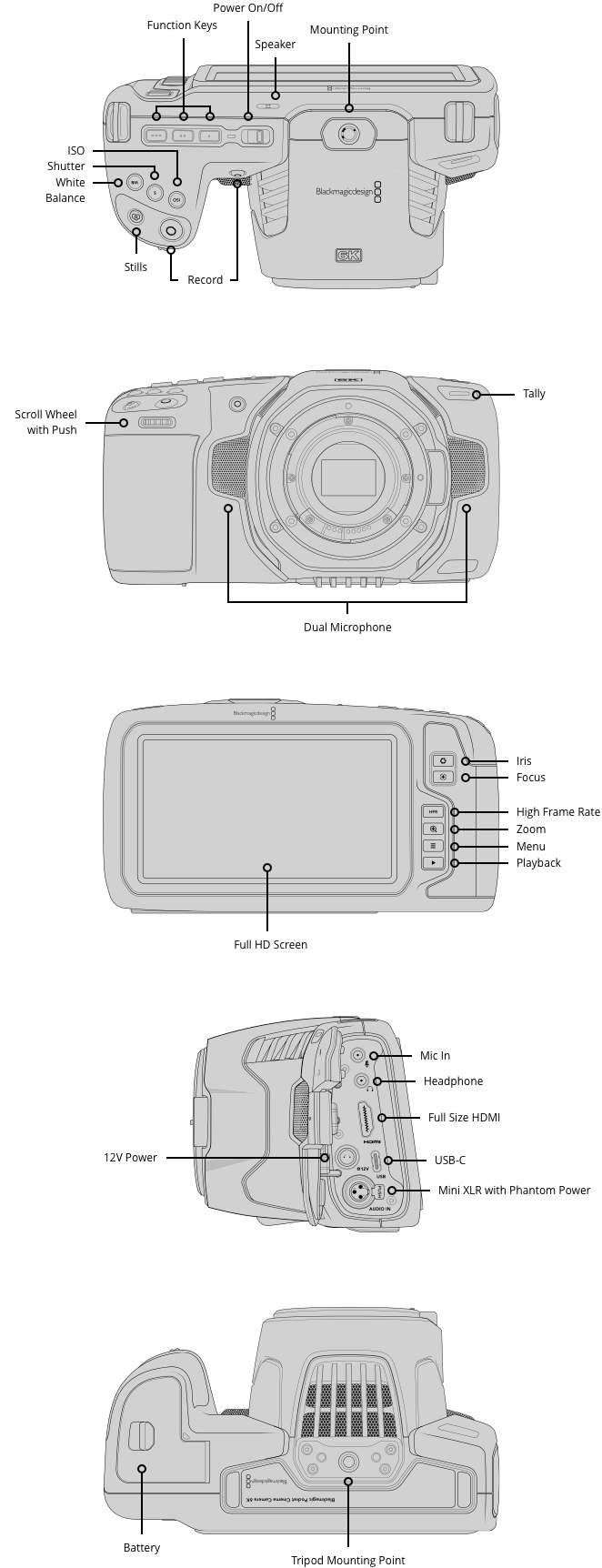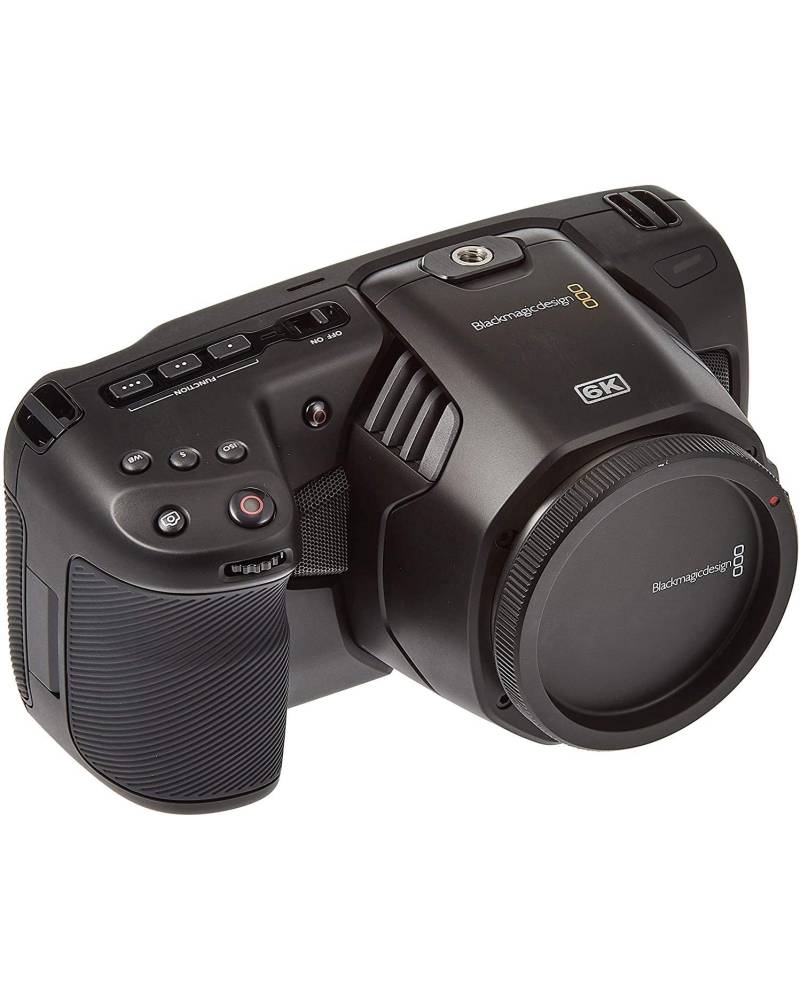Reference: CINECAMPOCHDEF6K
Blackmagic Pocket Cinema Camera 6K (Body only)
Contact us to or
- Active Canon EF Mount
- Super 35-Sized HDR Sensor
- Record 6K 6144 x 3456 up to 50 fps
- Dual Native 400 & 3200 ISO to 25,600
Inside the box:
- Blackmagic Pocket Cinema Camera 6K G2
- Lens turret dust cap
- Camera strap
- 30W power supply with locking connector and international adapters
- NP-F570 battery
- NP-F series battery USB charger
- Welcome booklet
- DaVinci Resolve Studio activation key
 Shipments all over the World
Shipments all over the World
We ship daily via the most careful express courier, such as UPS, FedEx, DHL
 Secure Payments
Secure Payments
Secure Payments - Pay with all Credit Cards or Paypal
 Easy Returns, Shop with Confidence
Easy Returns, Shop with Confidence
If you are not fully satisfied with your purchase, let us help you with a replacement, or return
 Tailor Made Solutions
Tailor Made Solutions
We are the experts. That’s why we can achieve the best solutions for your projects. Contact us and
 Assistance
Assistance
We believe in dialogue and in people. That’s why we guarantee you continuous assistance
- Screen size
- 12,7 cm (5")
- HDMI
- Sì
- Video Quality
- 7K HDR
- Resolution (MP)
- 21.2
- Lens Mount
- EF
- Media
- SD; C-Fast 2.0
- Video Out
- HDMI
The Blackmagic Pocket Cinema Camera 6K
For the second generation of the 6K BMPCC, Blackmagic basically took the 6K Pro model and removed the built-in ND filters.
In fact, compared to the first 6K we have the tilting screen, support for the electronic viewfinder, the second mini-XLR input, and a switch to the more convenient batteries in Sony NP-F standard. I already have a 6K and a 6K Pro, but I had the chance to try the G2 for a few weeks and I tell you a little about my experience.
Now the 6K G2 retains the Super 35 sensor but, like the 6K Pro, still grows to accommodate the new technical features. What clearly distinguishes the cameras in this series from the others is the format, which is very similar to that of a large camera. Of pocket there is really nothing, but the BMPCC 6K G2 is smaller than many camcorders and is ready to use without any accessories.
The 6K G2 has the same Super 35 sensor as the previous model and the Pro, again with a Canon EF mount. It is similar to the APS-Cs that are used in photography and the exact size is 23.10 x 12.99 mm, so it is a native 16:9 a little wider than the APS-C used by Canon (22.2 cm) and a little narrower than the standard Sony/Nikon/etc... (23.6 mm). Consequently there is the usual lens multiplier to consider.
The body is made of a mix of polycarbonate and carbon fiber to keep the weight down, which is still 1.2 kg. In the hand it does not give a particularly good feel, but I could not say why. Probably the fact that it is so bulky does not play in its favor. If I had to make a summary judgment I would give it a 7 out of 10 in this respect.
One of the new design changes, also shared by the 6K Pro model, is that there are now two threaded holes at the base and no longer just one as in previous versions, so it no longer has that annoying tendency to rotate on the attachment plate or in the cage.
The controls are very intuitive and simple, with a good number of physical buttons and an effective touch interface. The video recording button is at the top, in the typical camera position, but there is a second one at the front that I never use: I would have preferred to have an additional one at the bottom, where the 6K lettering is located. Also at the top is a button for capturing photos: this might seem like a completely useless thing, but these are 21.2 MP shots in uncompressed DNG format, so they are not trivial frames extrapolated from a video.
A little further back are quick accesses for ISO, shutter speed and white balance: once pressed, you can use the front wheel to select your chosen value. Note that you can also operate via the display alone through the use of the touchscreen.
The physical power on/off switch is always located in the upper right area, next to three customizable buttons. With these you can decide to show or hide various information on the screen, either on the internal one or on others that may be connected via HDMI. Everything is manageable of the settings in a precise and granular way.
On the back are two buttons at the top, the first of which allows you to control the aperture on lenses with electronic contacts. The first press can perform an automatic exposure, but it is also controlled with the front wheel or again via the touch display. The second button activates focus, a topic we will discuss more later. At the bottom are 4 other buttons arranged in a column and are used to activate the HFR (High Frame Rate) mode, zoom, menu, and playback.
Dominating the rear area is the large 5" Full HD LCD screen equipped with a very precise and responsive touchscreen. Articulation is new to the Pro/G2 models and allows the display to be tilted up 90° or down about 45° for viewing with the camera raised or lowered. Unfortunately, this is not the same 1500-nit display that was recently introduced in the 6K Pro, so you can't see as well under direct light. And this is basically the G2's only other waiver from the Pro version, along with the built-in ND filters I mentioned earlier.
For those who want better viewing there is now also support for the Pro EVF.
For video storage there is ample freedom of choice, either by the dual SD UHS-II and CFast 2.0 slots on the right, or via the USB-C port on the left, onto which portable SSDs such as the Samsung T7 can be attached directly. Connections are all arranged behind two rubber flaps and include:
- 3.5mm microphone input
- 3.5mm headphone output
- HDMI output (with 1080p/HDR/10bit resolution)
- USB-C port (for disks, upgrades or remote control)
- 12V power port with locking system
- 2 mini XLR audio inputs with phantom power support

One of the most interesting aspects, for me, is precisely in the handling of audio. No "camera that also does video" natively has such a variety of inputs and support for powered XLR microphones, except with often very expensive additional accessories. On the negative side it must be said that only two of these channels can be recorded, separated into a stereo stream, whereas it could have been as many as five considering the 3.5mm input and the two stereo microphones included with the camera.







